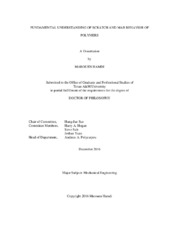| dc.description.abstract | Scratch behavior on polymeric films was investigated. The effect of film orientation and architecture on scratch resistance was determined. Film orientation was obtained by uniaxial stretching and its architecture was modified by the addition of ethylene comonomers. Model polypropylene (PP) and polyamide (PA) systems were employed to study the effect of laminate structure on scratch resistance. Also, mar behavior on bulk polymeric materials was investigated. The impact of brightness, transparency, and color as well as surface friction and texture on mar visibility resistance was determined. These studies were conducted based on fundamental, experimental, numerical, psychophysical, and statistical approaches. Experimental tests were conducted with accordance to ASTM/ISO standard. They were complemented by numerical simulations performed using a sophisticated FEM model. The psychophysical approach is performed through human observation tests to validate the experimental findings. The obtained data was analyzed using multidimensional scaling (MDS) statistical approach.
Scratch analysis demonstrates that scratch resistance is improved with higher film orientation and lower ethylene content. The FEM analysis shows that this improvement is associated with surface-to-interface shift of stress concentration. It is also found using the parametric analysis that scratch resistance is mainly improved due to higher film hardening coefficient and yield stress, but is insensitive to film modulus. It is also found that PP/PA has better scratch performance than PA/PP. This is mainly due to PP/PA low surface friction and graded structure, where upper PP layer absorbs scratch energy and lower PA layer protects the interface from high stress built-up. Mar analysis demonstrates that mar visibility resistance decreases with green, dark, smooth, and high-friction surfaces. Also, MDS results show that brightness, transparency, and color have respectively considerable, moderate, and insignificant effect on mar perception. Experimental findings indicate that mar visibility resistance can be quantified using the slope variation of mar contrast curve. FEM stress analysis shows that stress concentration is generated at the mar edge, then propagates towards inner mar area repetitively, reflecting stick-slip oscillations observed in experimental mar tests.
The results found in these research studies serve as a practical tool to effectively design polymeric systems with appealing scratch and mar performance. | en |


